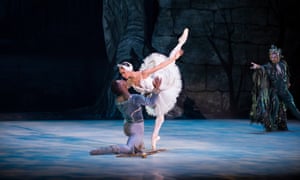Ballet dancers Brooklyn Mack and Misty Copeland made history last year when they became the first African American pair to perform in the lead roles of Prince Siegfried and the Swan Princess at a major production of Swan Lake.
“Even in 2015 something like this was unheard of, which seems crazy,” says Mack, speaking from the studios of the Washington Ballet Company, where he has been for nine years. “It was a much bigger deal than it should have been.”
The world of ballet has long been criticised for clinging to a centuries-old conservatism, and a lack of diversity persists. “There is a stigma that still pervades ballet culture; an idea that black bodies cannot conform to the constraints and aesthetics of ballet and it has greatly limited the number of opportunities dancers of colour have,” the 30-year-old explains.
But tickets to this particular performance of Swan Lake sold out in minutes. “Everyone who was in that theatre was there with a fervent thirst for change and I could feel a palpable energy and anticipation coming from the audience before the curtain even went up.”
When the performance was over and it was time for the curtain call, Mack and Copeland were greeted with a thundering standing ovation.
It felt great, but then so do all his ballet performances, Mack says. “I was just concentrating on playing the role of Prince Siegfried to perfection first and foremost.” Every dancer is a perfectionist, according to Mack, who believes the biggest challenge to becoming a professional ballet dancer is accepting it will be a sacrifice.
Mack was 12 when he started going to ballet classes. “In order to pursuade my mother to finally take me to American Football tryouts I told her that I would be willing to go so far as to take ballet lessons. I figured that she would have no choice but to be moved by my level of resolve and agree.”
“You can’t have the same type of childhood or adolescence as your friends – it’s a struggle and it requires so much time and a lot of sweat and pain and tears.” Every day he takes on a punishing eight-hour routine. “You need to practise for hours, even when your tendons are screaming at you to stop.” It often means skipping that night out at a club with friends and instead staying in the studio to perfect something ahead of a big performance.
And it’s a commitment ballet dancers invariably have to make very early on. “It’s a short-lived career and you’re always battling against time to reach perfection, so you need as much of it on your side as possible,” he explains. Most men tend to retire in their late-30s, while women often retire by their mid-40s.
Mack remembers the moment he knew he wanted to be a professional ballet dancer. He was 14 years old, sitting in the back of his mum’s car coming home from ballet practice. “I had just received a scholarship from Kirov Academy of Ballet in Washington DC, and I thought, wow, am I really going to do this? It was a sobering moment.”
As the academy was a seven-hour drive from his home in South Carolina, it meant packing up and moving there. But he took the plunge and hasn’t looked back.
Growing up, Mack says he had a strong sense of who he was, and steeled himself for ridicule. He didn’t get as much as he expected. “Ballet would often be the butt of a joke, and when I told people I was a ballet dancer I would see their face contort, as if they were having some internal struggle with how and why I, a man and an African American, was a ballet dancer.” As an adult, he finds a lot of people are intrigued and want to know more and he enjoys the positive reception.
There are a number of misconceptions and stereotypes around ballet dancers and what it is to be a professional, he says. The biggest? The first is that people perceive dancing, even at his level, as a hobby. “I tell people I’m a dancer and they still ask, ‘but what do you do?’” The second is that ballet dancers don’t eat and the third is that ballet is a purely physical endeavour and intelligence isn’t an asset many dancers need, or have. “People say things that imply that mentality but I have never met a great ballet dancer who isn’t intelligent.”
All that choreography, thousands of steps and painstaking timing and precision – not to mention the ability to convey so much emotion, without saying a word – makes being a ballet dancer a challenging career. But the payoff, he says, is immense.
“There is a euphoria when you perform and everything comes together – the music and your entire being,” he explains. “If you are portraying a character in love, for those moments you are in love with whoever you are dancing with because you have such an intimate connection with them.” And there is a connection with the audience, he adds.
It’s a beautiful and unique career but it’s also a fleeting one. “It’s bittersweet and I doubt there is anyone who doesn’t reminisce and miss it once it’s over,” says Mack. “But you still have more than half your life ahead of you when you retire so you can transition into something completely different afterwards.” He already has plans to open a restaurant when he retires.
Mack’s ascent to professional ballet dancer at a world-class company was, clearly, no easy feat. What does he think it takes to get there? “Tenacity and a hell of a lot of internal fortitude,” he replies. You might be a big fish in your local school but the step up to company life, and the criticism you will encounter, can be very humbling, he adds.
“You also need something that sets you apart from other people, something that draws them to you.” It could be an amazing jump or turn. Find what’s unique about you and capitalise on it, he says. “If you find that something that inspires awe in people, then that’s your ticket – run with it.”
[Source:- Gurdian]




